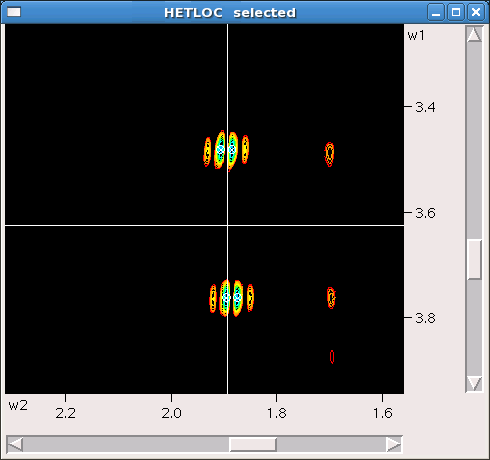Analysis of HETLOC data
From NMR Wiki
HETLOC [1, 2] experiment can be used to obtain one, two, three and more -bond separated heteronuclear J couplings, which depend on the conformation and stereochemical arrangement of atoms in the molecule.
Before starting to analyze spectrum, list the couplings to be collected (chances are all observable couplings won't be needed).
HETLOC experiment has a limitation that it won't show couplings to carbon atoms (or other X-nuclei to which HETLOC experiment might be tuned) if they are not connected to a proton.
Then, open HETLOC spectrum, and for a given coupling between atoms Cx and Hy:
- draw a horizontal line at ω1 (usually vertical dimension) = δ(Hx) - i.e. chemical shift of Cx-attached proton.
- draw a vertical line at ω2 = δ(Hy)
- alternatively move a cursor so that cross-hairs correspond to those lines
- note the point of intersection of the two lines
- somewhere symmetric to that point along the vertical line there might be two peaks or groups of peaks (i.e. if they are observable)
- two (groups of) peaks will be offset in ω1 by 1JCxHx and in ω2 -by the sought value of nJCxHy
You can notice that splitting in ω2 can be either positive or negative (how you define sign is a matter of convention). HETLOC experiment can distinguish relative signs of couplings.
Related documents
Sensitivity- and Gradient- enhanced HETLOC
Dipsi2etgpjcsix1, Sensitivity and Gradient- enhanced HETLOC
References
- KURZ, M and SCHMIEDER, P and KESSLER, H. HETLOC, AN EFFICIENT METHOD FOR DETERMING HETERONUCLEAR LONG-RANGE COUPLINGS WITH HETERONUCLEI IN NATURAL ABUNDANCE. Angewandte Chemie International edition in English 30(10):1329--1331, 1991. BibTeX
-
Uhr{\i}´n, D and Batta, G and Hruby, VJ and Barlow, PN and K{\"o}v{\'e}r, KE. Sensitivity-and Gradient-Enhanced Hetero ($\omega$1) Half-Filtered TOCSY Experiment for Measuring Long-Range Heteronuclear Coupling Constants. Journal of Magnetic Resonance 130(2):155--161, 1998. BibTeX


